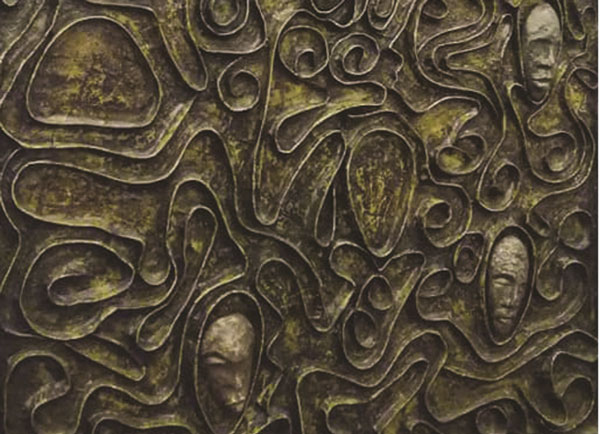
A new exhibition asks questions that annoy and delight
Kampala, Uganda | DOMINIC MUWANGUZI | A painting of a nun piously crossing her hands, engrossed in prayer, hangs at the entrance of Ronex Ahimbisibwe’s exhibit. Atop the painting, on the right hand side, is a rosary hanging as if it is an installation rather than a sacred symbol of the catholic faith. The rosary is a medium of spiritual reflection and is occasionally recited by the penitents, represented here by the nun.
So what thoughts occupy the individual as they recite the rosary? Are they spiritual or secular thoughts? This is one of those experiences that the artist is questioning in his body of work titled `Contemplation’. It explores the idea of humans who, at any moment, live a certain experience or life, while thinking or desiring, another life altogether.
Ronex has in the past shown fascination with such juxtaposition of extreme contrasts; the ugly versus beautiful or naivety versus sophistication. He uses the approach to question relationships between them. This time, he looks at the concept of the ideal versus the reality.
Are we, as humans, more drawn to the reality or the ideal? Can human beings be contented living the reality or the ideal?
Ronex draws no conclusions. He instead delves more into the subject of the `what if’ such an interrogation on canvass reveals unexpected aspects of life’s contradictions. He constructs- he is a sculptor, printmaker and painter- irregular shapes from cardboards into artworks as a metaphor to life’s inconsistencies. In his paintings, he paints two or more artworks into one, to suggest the idea of varied thoughts that reside in one individual.
The media he adopts in his art are the found-objects that he collects from the environment. Ronex here seemingly suggests that what is considered waste by some people can be made valuable. He creates “canvases” from newspaper and magazine cuttings or denim jean rags, uses leftover automobile paints collected from motor garages in his neighbourhood to paint, and assembles nuts, bolts, aluminum or steel plates to construct his installations.
This experimental approach draws on the nature of his locale that is filled with humble settlements and innovative spaces like motor garages coupled with a dense population of the youth from the nearby Makerere University Kampala.
Inevitably, such an environment has a fast-paced life laced with ironies: a posh storeyed house amidst a crowded environ of shanty houses with garbage heaps everywhere, food kiosks next to public toilets and university students carrying expensive gargets like smart phones ,but living in shanty one room abodes- Muzigos.
Ronex’s art is a mirror of his inner-self: his aspirations, joy and frustration. They are the conflicted thoughts of someone who was brought up by a strict father and loving mother, who wanted him to study law, but he ended up studying art.
But even at art school, he was always uncomfortable with the traditional approach to fine art making. This trait of defiance, while reflecting on what everyone considers the usual, defines his artistic practice. Ronex never makes art to generally ease the mind of this audience. He instead incites emotions like anger, frustration, and confusion. His art evokes diverse conversations.
`Contemplation’ is no different. Its introspective tilt will be talked about. The artist figuratively examines a crucial aspect of human nature; its irony and hunger for something more, better. Human beings are never fully content with what they are or have. Yet they never find the better something they crave. Is better an illusion? Such contradiction inspires another question; why does mankind exist after all – to be happy or sad? Both can be experienced at once like Ronex’s art that can delight and annoy at the same time.
******
Ronex’s Contemplation exhibit is showing at Afriart on 7th, located on 7th street, Industrial Area, in the studios building.
 The Independent Uganda: You get the Truth we Pay the Price
The Independent Uganda: You get the Truth we Pay the Price




Some really choice posts on this website, bookmarked.